Rapid Response Times for Pest Issues with Pest Control Lockhart
Rapid Response Times for Pest Issues with Pest Control Lockhart
Blog Article
Discovering Problem and Therapy Methods in the World of Parasite Control
The landscape of bug control encompasses a myriad of obstacles, especially as infestations of usual home parasites proceed to evolve. Recognizing the behaviors and reproductive patterns of these hassles is vital for developing efficient treatment methods. By integrating precautionary measures with sophisticated management methods, such as Integrated Pest Administration (IPM), home owners can better guard their environments. Nonetheless, the effectiveness of these techniques might vary dramatically based on certain circumstances. What underlying aspects add to the success or failing of these techniques in various settings?

Usual Household Pests
When it concerns managing our space, comprehending typical family bugs is critical. These pests not just interrupt our convenience yet can additionally posture wellness threats and damages property. One of the most widespread house parasites consist of ants, roaches, rodents, termites, and bed bugs.
Ants, typically seen foraging in kitchens, can infect food and establish large colonies. Rodents, consisting of mice and rats, can create structural damages and bring diseases like hantavirus and salmonella.
Identifying the indications of these parasites, such as droppings, nests, or bite marks, is essential for very early intervention (Pest Control Lockhart). Appropriate sanitation techniques, sealing access points, and keeping a clutter-free environment are reliable preventative steps. By recognizing these common house insects and recognizing their behaviors, home owners can take proactive actions to mitigate invasions, ensuring a healthier living setting
Understanding Bug Infestations
Pest invasions can rise quickly, transforming a small annoyance into a substantial problem if not resolved quickly. Comprehending the nature of these infestations is essential for effective administration. Insects can attack domestic and industrial spaces for numerous reasons, including the search for food, sanctuary, or reproducing premises. Common elements adding to problems consist of inadequate sanitation, structural vulnerabilities, and seasonal modifications that drive bugs inside.
Determining the kind of bug is necessary, as various types display varied behaviors and reproductive rates. For example, rodents might develop nests in concealed locations while bugs like cockroaches thrive in damp settings. Early discovery typically rests on recognizing indicators such as droppings, chomp marks, or unusual sounds, which can show a trouble before it becomes extreme.
Ecological conditions additionally play a crucial function in pest spreading. Warm, humid environments can help with the rapid development of insect populaces, while modifications in landscaping or building can inadvertently develop favorable settings. As a result, regular examinations and preventative procedures are paramount to minimizing the risk of problems. An informed method to recognizing these dynamics lays the foundation for effective bug management methods in the future.
Treatment Techniques and Strategies
Effective therapy methods and methods are crucial for mitigating bug infestations and restoring a secure atmosphere. A complex approach is typically best, integrating chemical, organic, and mechanical approaches customized to the specific insect and the seriousness of the invasion.
Chemical treatments include using pesticides and herbicides, which can successfully remove parasites. Correct application and adherence to safety and security standards are critical to decrease threats to people and non-target microorganisms. Integrated Insect Administration (IPM) encourages the judicious use chemicals as a last resource, counting rather on tracking and threshold levels to establish treatment requirements.
Biological control approaches include introducing all-natural predators or bloodsuckers to decrease pest populaces. This method is significantly prominent, particularly in farming settings, as it advertises environmental sustainability.
Mechanical approaches, such as traps and obstacles, offer prompt relief from parasites without introducing chemicals. Alternatives include sticky catches for insects or physical obstacles for rats.
Eventually, the selection of treatment approach ought to take into consideration the specific bug, the environment, and prospective influence on human health and view it now wellness and ecosystems. A balanced mix of these strategies can successfully manage invasions while advertising lasting insect control options.
Preventive Steps for Residence
Proactively dealing with insect issues before they intensify is essential for maintaining a healthy home atmosphere (Pest Control Lockhart). Applying effective precautionary procedures can significantly reduce the probability of problems, inevitably safeguarding both your residential property and health

Proper landscape design additionally plays a crucial role in prevention. Maintaining hedges and trees cut away from the house reduces the chances of insects locating their means indoors. Make certain that drainage systems are working effectively to avoid standing water, which can draw in insects and other insects.
Last but not least, regular assessments are recommended. Frequently looking for indicators of bug activity enables very early intervention. By taking on these precautionary measures, homeowners can produce an environment that is much less congenial to pests, therefore improving their general lifestyle and minimizing the need for considerable bug control interventions.
Industrial Pest Control Methods
An extensive strategy to industrial parasite control is vital for businesses aiming to keep a safe and sanitary environment. Efficient approaches involve a mix of normal evaluations, staff member training, and the implementation of Integrated Bug Management (IPM) methods.
Routine inspections allow very early discovery of insect task, permitting for timely intervention. Services need to develop a routine timetable for these analyses, concentrating on high-risk areas such as cooking areas, storage space rooms, and waste disposal sites. Worker training is just as crucial; official site team should be enlightened on the indications of bug infestations and the value of reporting them instantly.
Executing IPM practices assists mitigate pest check these guys out problems sustainably. This consists of environment alteration, such as securing access factors and reducing clutter, as well as employing natural deterrents before resorting to chemical treatments.

Moreover, collaborating with a certified insect control supplier makes certain accessibility to professional understanding and sophisticated treatment options. This partnership can lead to customized parasite control intends customized to the certain requirements of business, reducing risks and enhancing total efficiency. Eventually, a positive and informed strategy cultivates a pest-free atmosphere, protecting both public health and organization online reputation.
Verdict
Finally, effective parasite control requires an extensive understanding of common house bugs and their behaviors, paired with targeted treatment methods. Applying precautionary actions together with therapy approaches such as Integrated Pest Monitoring and organic control improves the capability to minimize invasions. Regular evaluations and a combination of chemical and mechanical remedies even more add to preserving pest-free environments. Eventually, an all-around strategy to pest administration is essential for securing living spaces from unwanted burglars.
Report this page